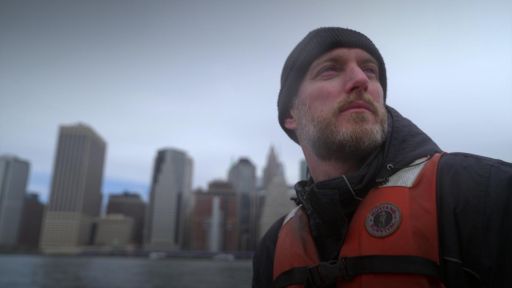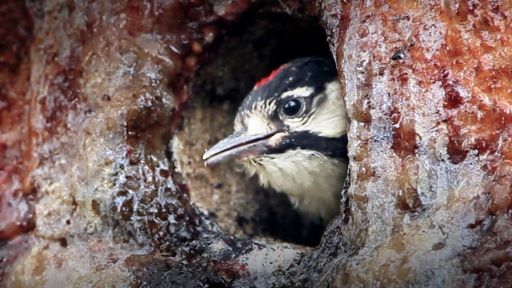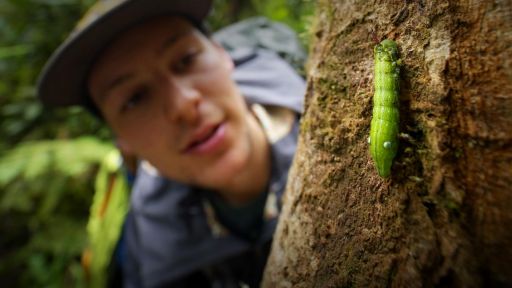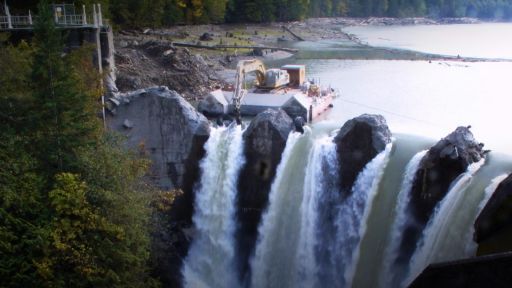TRANSCRIPT
♪ NARRATOR: Australia, a country that goes by many names.
The land down under.
Oz.
They conjure an otherworldly place filled with fantastical creatures.
The reality isn't far off.
Animals, unlike any other's on Earth, evolved and thrived in isolation on this island continent for about 30 million years.
But today, these national treasures are under siege from forces we have unleashed on their world.
Invasive species, habitat loss, and climate change.
TOM: We have one of the worst records for loss of our native species.
We have unique animals, and it isn't until we actually see them disappear that unfortunately we take some action to try and alleviate that problem.
NARRATOR: Saving Australia's wildlife from threats we created is a daunting task.
Which is why conservationists are seeking help from some surprising allies, some of our oldest and most beloved four-legged friends.
♪ It's morning in Queensland in Eastern Australia and a man and his dogs are getting ready for a big day.
TOM: My name's Tom Garrett and I'm a conservation dog handler.
And I'm in charge of a team of two English Springer Spaniels.
NARRATOR: Tom's dogs, Rocky and Cooper, are in many ways just like any other dogs.
TOM: Good boy, yes.
NARRATOR: They like to play, they love their human, and it's clear he lo ves them right back.
INTERVIEWER: They always drink out of your hat?
TOM: Yeah, well, it saves carrying a container.
NARRATOR: But Rocky and Cooper aren't pets.
They've received special training to become conservation dogs.
TOM: Show me, show me.
Conservation dogs work in an area with threatened species, with weeds, with pest animals.
And being a canine that has a very sensitive nose, reportedly 6,000 times more sensitive than the ones we have on the end of our face, they're very effective in tracking animals and following scents.
NARRATOR: The idea of using dogs for conservation... TOM: Come on.
NARRATOR: ...is catching on in Australia.
Especially when it comes to combating perhaps the number one menace to the country's native wildlife, invasive species.
TOM: I became involved about seven years ago with the conservation dogs, particularly on locating foxes and fox dens.
Fox!
Find the fox!
NARRATOR: Foxes are but one of many invasives plaguing Australia.
Rabbits, feral cats, cane toads, and others have wreaked havoc on plant and animal species that haven't had time to evolve defenses against them.
But the 1.7 million foxes that live here today are among the most destructive, killing about 300 million native animals a year.
And they share one thing in common with almost all the other invasives.
They were brought here by people.
COL: Way back with the first settlement of Europeans into Australia someone had the bright idea that we ought to have foxes here so we could have fox hunting.
And when I was a- a child in the 1940s, a young person in the 1950s, foxes were very uncommon.
By the 1960s and into the '70s, they're actually becoming quite common.
TOM: This type of ecosystem here on the coast is really ideal real estate for these foxes to live in.
We have sandy, loamy soil which the foxes can make a den in and breed in every year.
There's lots of native animals for them to predate on.
NARRATOR: The foxes here have developed a taste for one embattled creature in particular.
Sea turtles.
The nearby coastline is home to the largest nesting population of loggerheads in the South Pacific.
They and other marine turtles here have been targeted by the foreign predator when they're most vulnerable.
For decades, foxes have terrorized the turtles' nests.
COL: When we started our turtle research here in South Queensland in the 1960s, we very quickly realized that foxes were a problem.
We understood that you had to have at least 70% of your clutches that were being laid on various beaches surviving.
When you went on to a beach and you were seeing 30, 40% being destroyed by foxes, you were not in a sustainable population.
NARRATOR: In some areas, foxes were devouring up to 95% of the turtles' clutches.
But the problem wasn't just how many turtle eggs the foxes were eating, it was also where they were feasting on them.
COL: One of the things that's come out of the research we've done is the sex of the hatchling turtles is determined by the temperature of the nest.
The mainland beaches, they've got brown sands and they're quite warm.
The islands offshore in the Southern Barrier Reef got white coral sand and white sand is reflective, two to four degrees cooler.
The warmness gives you more females and coolness gives you males.
NARRATOR: Foxes are found mostly on the mainland.
COL: So our fox predation is primarily on the beaches that give us the majority of our female hatchling production.
NARRATOR: By eating too many females, foxes were jeopardizing the entire population.
So in 2014, Col tried to stop the spread of foxes by launching a program called Nest to Ocean.
The initial strategy didn't pan out.
COL: We were trying to control foxes by baiting and it really wasn't working.
The foxes very quickly learned to avoid the baits.
And then one of our park staff got the idea of bringing in dogs that were trained to sniff out the presence of the foxes and to follow their scent trails back to the dens.
TOM: Good boy.
NARRATOR: That's where Tom and his dogs came in.
TOM: Cooper, come on.
Yep.
NARRATOR: These two are experts at finding fox dens, but some pups are better at it than others.
TOM: Just like us, each individual dog has its own idiosyncrasies and its own habits.
They're all a little different.
Rocky, sit.
Rocky's been with me for the best part of nine years now.
Stay My family's grown up and moved away from home so Rocky's perhaps more part of the family for me now than- than my children are.
What you got, Rocky?
Hey, where?
Show me.
Because Rocky and I spend so much time together working.
Oh, good boy.
NARRATOR: Cooper, meanwhile, is still a conservation pup in training.
TOM: Cooper's got a wonderful nose.
He's a very exuberant, young dog, full of work ethic.
Come on, Cooper.
But it's gonna take a little while for Cooper and I to understand each other.
Show me.
Show me, Cooper.
Show me, Cooper.
Yes.
So this is one of those older dens that I knew existed in this area, but obviously you could see Rocky followed it down.
Cooper's just lost his ball down there so he is trying to regather his ball.
I'm gonna have to have a lot of tennis balls with you Coop, aren't I?
The dogs have done such a good job that people book us every year to make sure that they're keeping the fox numbers under control so that we can stop predation or at least alleviate the problems that foxes are causing.
NARRATOR: No one's more familiar with the scourge of invasives than those who have lived here the longest.
Tom's colleague, Rob Geary, works for an Indigenous ranger program.
And a member of the Taribelang Bunda Aboriginal community, he sees saving sea turtles as paramount to preserving his heritage.
ROB: This area has a lot of cultural significance for our traditional people.
The turtles have been in our traditions for many years.
They're also source of food, source of stories that are told to the children.
Over the years, we've lost a lot of our turtles but now we come here every year to try and bring the stocks back up.
TOM: Coop.
NARRATOR: A key component of Rob and Tom's strategy is camera trapping, which helps them zero in on the best spots to deploy the dogs.
ROB: So we've set these up every 10Ks along the beach just to let us know where the foxes might be, where they're coming through.
NARRATOR: Knowing if foxes are here now, just as they're beginning to breed, is crucial for safeguarding sea turtles.
TOM: Lots of images on here.
Right, you can have a look.
NARRATOR: And for Rob, a way of life.
ROB: Definitely something there.
See the legs in there?
[camera clicks] There.
There's a fox.
[camera clicks] Yep, there's another one.
[camera clicks] Looking right at you.
TOM: Rocky.
NARRATOR: Their dens must be nearby.
TOM: Fox, find!
NARRATOR: It doesn't take long for the dogs to sniff one out.
TOM: Show me.
Show me.
Good boys.
Yes, good boys.
So dogs are both indicating on a fox den and they've both shown great interest.
They've actually put their head in the hole and started to dig.
So that's indication that the den is actually active and the foxes are using it.
Good boy.
NARRATOR: Once a den is found, Tom and Rob gear up to shut it down.
TOM: So there's the fumigant.
It's the only one registered to do this sort of work in Australia for foxes.
It's carbon monoxide so it takes the oxygen out of the red blood cells and the animals just simply go to sleep.
NARRATOR: It might be difficult to watch, but for Rob, it's a necessary step in restoring this ecosystem to what it once was.
ROB: I'd love to have seen what it was like 250 years ago before the white man got here.
I think our land would've been just beautiful.
We had our own animals here.
We didn't need foxes.
And now 250 years later, we're here trying to fix the problem.
♪ NARRATOR: In the time since Tom, Rob, and the dogs have been working in South Queensland's Wingara Coast, they've eliminated hundreds of fox dens, giving turtle hatchlings a much better chance at survival.
COL: We've been using sniffer dogs now for six years, and in those six years we have not lost a single clutch of eggs to foxes on the Wingara Coast.
It is a dramatic success, but it goes a lot further than the turtles.
A few years ago, it was so rare to see the native, small mammals.
In the last couple of years, we are seeing bandicoots all over the place.
We are seeing the little marsupial carnivores and so it's a benefit for the whole suite of native animals.
TOM: Here.
NARRATOR: Dogs are proving their mettle in the fight against foxes.
But invasives are only one of the threats endangering Australia's native species.
Nearly 90% of Australians now live in urban areas and the growing sprawl is squeezing native animals into ever-shrinking habitats.
Climate change is also wreaking havoc.
Massive bush fires from 2019 to 2020 killed or displaced as many as three billion animals, a disaster known as The Black Summer.
One of the creatures most affected by urban sprawl and climate change is perhaps the country's most cherished, the koala.
In Brisbane, about 200 miles south of where Tom and his dogs are saving sea turtles, another conservation dog team is prepping its pups to help the beloved marsupial.
OLIVIA: All right.
Can you run the hot water, please?
My name is Olivia Woosnam.
I'm the co-director of OWAD Environment.
That's good stuff.
We're independent environmental experts in improving how we do conservation in Australia.
Can you give the scale again please?
ALEX: Oh, yeah.
OLIVIA: I've always lived with dogs my whole life.
They are specialists in communicating with us and wrapping us around their little finger.
They're very good at that.
[laughs] Missy, Taz, in your spot.
Thank you.
Wait.
Okay, Missy.
Good girl.
Taz, you ready?
You can have it when I say three.
One, two, three!
Good girl.
Our two field detection dogs, Taz and Missy, are working line English Springer Spaniels.
Their job, where they come in in the field is data collection.
Just one at time, thank you.
We focus on a few target species.
One of them is the koala.
All right, let's go.
The koala, it's got a re ally interesting position, both ecologically and socially.
It's iconic, everybody knows the koala.
NARRATOR: But it's more than just a cuddly symbol.
Koalas are indicators of ecosystem health.
OLIVIA: These types of species are called flagship species and so basically if the koala is doing well so are a whole lot of critical flora and fauna species that everybody depends on, including us humans.
These are the ecosystems that filter our water.
These are the trees that enable us to breathe and give us shade.
Koala... find!
NARRATOR: So what have koala's been telling us over the past few decades?
The world they live in is ailing.
OLIVIA: There used to be a lot more koalas right across Eastern Australia than there are today.
Over the last a hundred years or so, big cities, railways, highways, main roads, have been putting a lot of pressure on the koala and their habitat.
The koala is one of those species who needs to move around.
They need to disperse.
It's vital.
Part of our job is to help them have a bit of a easier time navigating through an increasingly challenging landscape.
NARRATOR: First, the team has to find the koalas.
[dog barks] ALEX: She's moving.
OLIVIA: Yeah.
NARRATOR: That's easier said than done.
But with the help of detection dogs, Olivia and Alex, her husband and collaborator, are able to track their movements.
Well, their bowel movements, that is.
[dog barks] ALEX: Oh, she's got some.
[dog whines] [dog barks] OLIVIA: Yes!
[dog barks] NARRATOR: The next step is gathering data.
OLIVIA: The reason why you have detection dogs for koala scats is the DNA.
The koala DNA and the pathogenic DNA.
Ooh, there's a nice one.
ALEX: Oh yeah, that's pretty fresh.
OLIVIA: Each koala has its own unique DNA profile.
NARRATOR: The profile offers insights into the koala's health and genealogy.
OLIVIA: Yep, that's it.
Okay, all right.
♪ Eventually, when you have enough data for any given region you can see how many distinct populations do we have in that area.
Are they naturally distinct or have they become distinct because of habitat fragmentation?
Here, I'm focusing on Brisbane City Council.
NARRATOR: As in many other urban areas across the globe, habitat fragmentation is on the rise around Brisbane.
Olivia's data have shown that koalas here are now isolated in three pockets.
And even within those pockets, populations are increasingly cut off from each other, a threat to their survival.
OLIVIA: When you've got groups of koalas that become isolated in one small patch, you can have loss of genetic diversity which can weaken their immune system.
All you need is one fire, one nasty pathogen, to get in there and it'll just rip right through.
NARRATOR: The Black Summer bush fires were a devastating example.
The blazes killed or displaced some 61,000 koalas.
♪ Fragmentation inflicts other harm as well.
OLIVIA: When you've got an isolated patch which is otherwise completely surrounded by an inherently dangerous landscape, what happens is they end up getting smashed on the road over and over.
NARRATOR: In Southeast Queensland alone, cars kill about 300 koalas a year.
But now, data Olivia and her dogs have gathered are helping urban planners identify where koalas are most likely to cross roads and offer them safe passage.
OLIVIA: So this is one of the latest structures that Brisbane constructed over an existing road.
You can see the young trees there are starting to come up already.
The beauty with such overpasses is that they look after themselves and there's very little maintenance required.
NARRATOR: This new wildlife overpass is surrounded by fencing that prevents koalas from crossing elsewhere.
And camera traps have revealed that koalas are taking advantage of structures like this across Brisbane.
OLIVIA: By adding this one here, it means they now have three very big patches of bushland that have been reconnected and they're entirely secured.
We need to secure large functional corridors right now and protect them forever so that when these areas do come with the pressure from development, they're already no-go zones.
That's really the most effective way and also the cheapest way of achieving real conservation is to plan ahead.
NARRATOR: For Olivia, planning ahead isn't just about smarter urban design.
It's also about sparking interest in conservation at an early age.
Which is why she often shares her passion for nature, conservation, and pups with the leaders of tomorrow.
OLIVIA: All right.
Should we have a little chat about doggies?
[children giggle] We do a lot of education and particularly we like to intervene with the younger generation.
Okay, let's be clear.
Dogs are awesome, right?
Who's with me?
Yeah, most of you are.
Detection dogs are not kid-compatible, so unfortunately we cannot let them interact.
However, for all these training workshops we have a PR officer who's also our pet dog, Shaggy, and he is specifically trained to teach people what they can do with their own dog at home.
There's a lot of wildlife, native wildlife around us.
They're not used to dogs.
They don't know how to protect themselves against dogs.
It's our responsibility as dog owners to make sure that our dogs aren't an additional threat to the wildlife that we care about.
Shaggy is starting to- to meet and greet you.
[laughs] ♪ Yeah, well done!
NARRATOR: In her presentations... OLIVIA: We'll do sort of a semi-circle.
Semi-circle, move, move, move.
NARRATOR: Olivia teaches kids the basics of dog training.
GIRL: Sit.
No, sit.
OLIVIA: Yes.
Well done!
She's got it!
NARRATOR: And also how to call them off when they're harassing native species.
BOY 1: Bang.
BOY 2: Bang.
[children laugh] OLIVIA: Well done!
NARRATOR: The hope is to help kids grasp the power they can wield as conservationists.
OLIVIA: You can have all the knowledge and all the amazing science doesn't mean anything.
It doesn't achieve anything out there tangibly in the real world until you do something with it.
It's all about doing what you can in your own backyard.
That's all that matters really.
CHRISTY: People like Alex and Olivia and their dogs, what they've been able to contribute to koala conservation is just amazing.
It's absolutely fabulous.
So can we give them a clap?
[children applaud] NARRATOR: In the animal kingdom, every creature has its own distinct set of abilities.
We humans aren't known for our sense of smell, but we've at last come to realize that a powerful conservation partner has been hiding right under our noses.
OLIVIA: Our dogs are really an extension of us and are here to fill a gap.
Her reward, it's not so much chasing the ball, it's more holding the ball in her mouth and having a belly rub.
[laughs] Good girl!
I don't know if I'm religious or not, but whoever came up with dogs is awesome.
[laughs] NARRATOR: Across Australia, dogs are helping us study elusive platypuses, expand Tasmanian devil populations, and even protect little penguins from predators.
[dog barks] Both here and around the world, they can make us more effective conservationists.
TOM: I think it's just an entirely untapped potential for those type of dogs to be working in ecology and anywhere we need to know how we can react to the problems we're facing in the future.
NARRATOR: They're helping us safeguard native species and offering fresh hope that long-cherished ecosystems can be restored.
ROB: When my great, great-grandkids are walking around, I'd love for them to see the turtles hatching and heading back to the ocean.
[waves crashing] This whole ecosystem, I watch it change, I watch it regrow.
We're watching the turtle population get bigger.
I'm hoping they'll still get to see all that in future generations.
[waves crashing] ♪ ♪







